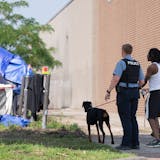One in six days of inpatient care is unnecessary now in Minnesota hospitals — a level of inefficiency that is causing backlogs in emergency departments and leaving patients waiting hours to receive treatment.
The Minnesota Hospital Association issued that finding Wednesday after surveying 101 hospitals across the state and discovering that a backlog, which emerged during the pandemic, is becoming a permanent problem. Patients spent 65,000 more days in inpatient hospital beds than needed in the five-month period ending in October — after the COVID public health emergency had ended.
“We cannot have this become the new normal for our patients across the state and in all of our communities,” said Dr. Rahul Koranne, president and chief executive of the trade group for the state’s hospitals. “The sheer magnitude of the number of patients stuck up in the [hospital] units is immense and it is backing up the entire system.”
A loss of 3,000 nursing home beds in Minnesota since 2020 has left hospitals with nowhere to send patients who are ready to leave but still need rehabilitation services before they can go home. The backlog is costly for hospitals, which don’t get paid by insurers for unnecessary inpatient care, and frustrating for patients who suffer delayed treatment.
Melanie Wickersheim, a heart and kidney transplant recipient, said she endured delays getting into the emergency room at M Health Fairview’s University of Minnesota Medical Center last week, despite severe vomiting and diarrhea.
The medics who brought her by ambulance were surprised as well, she recalled. “They were looking at the clerks like, ‘Aren’t we going straight back?’”
Wickersheim said her health stabilized once she got beyond the ER waiting room and she received medications and fluids, but that the delay prolonged her discomfort. The 39-year-old Minneapolis woman then remained in the ER for three days, because no inpatient beds were available, which in turn left other patients sitting in the waiting room or receiving emergency treatment in the hallways.
“It feels like a crisis,” she said. “I’ve been a patient for a long time, going in and out of emergency departments ... and I’ve never experienced this before.”



